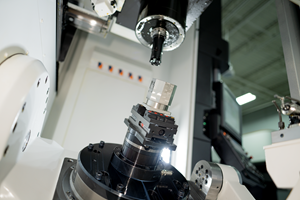For Many Machining Facilities, the Mindset Now Must Be “Radical Automation”
What if there will never, ever be enough talent in your local labor pool to meet the still-growing demand for skilled manufacturing employees? The real challenge might lie in our expectations about how much skilled labor we need. Let IMTS 2018 be the beginning of facing this challenge.
Think “radical automation.” In 2018, I believe these two words capture the aim and the mind-set many shops will need to bring to the International Manufacturing Technology Show (IMTS). The value of the event is not just in evaluating technology for today’s pressing needs but also discovering the ideas that will be at the heart of meeting a shop’s needs five to eight years from now. And across that window of time, one of those needs is almost certain to be delivering more output using the same or fewer skilled employees.
Our industry has been talking about the “shortage” of skilled employees with the same urgency for almost 10 years now. We’ve been talking about it since the start of the rebound from the Great Recession, and efforts in this area have shown success: CNC programs in community colleges are now far more popular than they once were. Yet even these gains are not enough to keep up as older employees retire and manufacturing activity continues to advance. We might have to accept that we will never have enough skilled manufacturing employees in the labor pool to keep pace with expanding processes that continue to assume today’s ratio of people to production. Therefore, it is time to change those processes, and it is time to change the ratio.
This gets to why I placed the word “shortage” in quotation marks. The so-called shortage of skilled employees exists only because of today’s assumptions and requirements as to how much staff is needed to deliver a given output. For any particular shop, I do not know what the elements will be of the future process that will enable that shop to change its staffing assumptions and requirements, but I do believe the core technologies are already out there to be found.
That’s why, when I speak of radical automation, I mean it in two ways. One is a radically greater commitment to automation than the team in your facility might have ever imagined seeing. The other is a radically expanded sense of what automation might include. It will probably include robots, yet robots alone likely are not enough. What else can omit significant labor? Multitasking is potentially automation. Additive manufacturing is automation, too, offering the chance to avoid the labor-intensive step of assembly. A more extensive commitment to CNC machining is also automation if it reduces the reliance on a near-net-shape process such as casting. And trying to figure out the possibilities of the Industrial Internet of Things (IIoT) offers avenues to automation yet to be explored.
All this will take time. Much of the work of getting from today’s point A to tomorrow’s point B will proceed slowly and will seem unproductive because it will consist of gathering important facts, challenging limited thinking and formulating a strategy to realize a new vision for production that is sufficiently big enough to meet the scope of opportunity your shop faces. So the time to begin is soon, and perhaps the perfect place to begin is this fall’s event in Chicago. In your pursuit of radical automation, let the first step be a radical rethinking of your goals for IMTS.
Related Content
Which Approach to Automation Fits Your CNC Machine Tool?
Choosing the right automation to pair with a CNC machine tool cell means weighing various factors, as this fabrication business has learned well.
Read MoreBuilding a 5-Axis Cell
5-axis machining has taken over the metalworking industry, but what goes into a high-functioning 5-axis machining cell?
Read MoreInside the Premium Machine Shop Making Fasteners
AMPG can’t help but take risks — its management doesn’t know how to run machines. But these risks have enabled it to become a runaway success in its market.
Read MoreFearless Five-Axis Programming Fosters Shop Growth
Reinvestment in automation has spurred KCS Advanced Machining Service’s growth from prototyping to low-and mid-volume parts. The key to its success? A young staff of talented programmers.
Read MoreRead Next
The Cut Scene: The Finer Details of Large-Format Machining
Small details and features can have an outsized impact on large parts, such as Barbco’s collapsible utility drill head.
Read More3 Mistakes That Cause CNC Programs to Fail
Despite enhancements to manufacturing technology, there are still issues today that can cause programs to fail. These failures can cause lost time, scrapped parts, damaged machines and even injured operators.
Read MoreObscure CNC Features That Can Help (or Hurt) You
You cannot begin to take advantage of an available feature if you do not know it exists. Conversely, you will not know how to avoid CNC features that may be detrimental to your process.
Read More
.jpg;width=70;height=70;mode=crop)















.png;maxWidth=300;quality=90)








